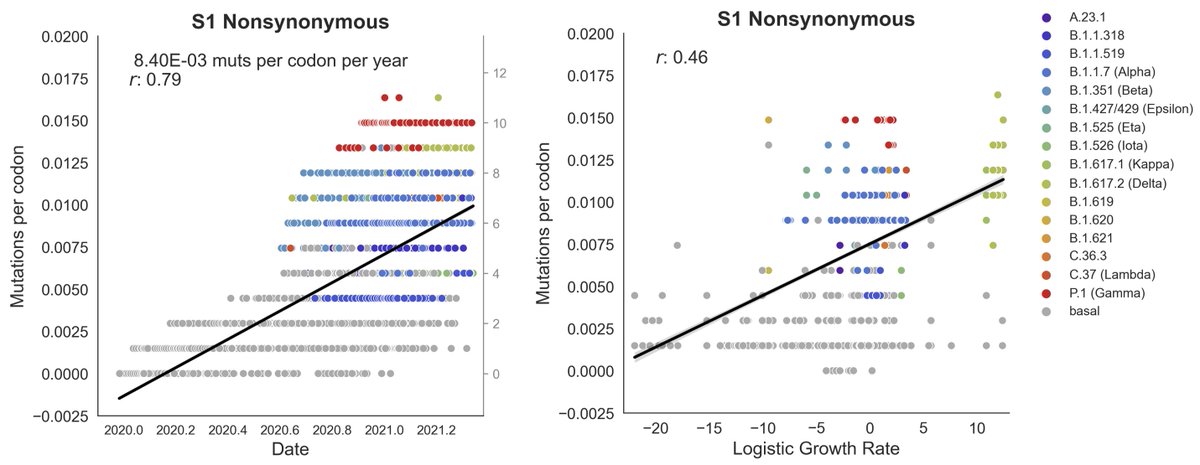
It looks like we're about at the peak of the Delta SARS-CoV-2 wave in the US (figure based on @CDCGov data). A thread on current circulation patterns and the impact of Delta. 1/14 

This inflection point in case loads at the country-level is due to decline in some states (such as FL and LA) and growth in others (such as OH and WV). Figure shows cases per 100k population on a log axis to emphasis state-level growth and decline. 2/14 

Using previously described method to split cases by variant frequency (
https://twitter.com/trvrb/status/1386694453289623557), we see a striking pattern in which most states have a moderate spring wave comprised of a mix of Alpha and other variants, but show a large Delta wave in the summer. 3/14

If we take the starting point for the US Delta wave at June 15th, we have a cumulative ~6.4M cases between Jun 15 and Sep 3, and if we assume 2.7 infections per reported case (
https://twitter.com/trvrb/status/1410376331003535363), we arrive at ~17.3M infections up to this point during the Delta wave. 4/14

Assuming there are approximately another 17.3M infections on the other side of the Delta peak (which may not be the case), we arrive at roughly 34.6M Delta infections in the US wave, which is pretty close to my forecast ~36M infections on June 30. 5/14
https://twitter.com/trvrb/status/1410376344735678468
Globally, we see that Delta is nearly dominant everywhere in the world except South America (nextstrain.org/ncov/gisaid/gl… showing distribution of samples from July 1). 6/14 

Delta appears competitive with endogenous South American variants Gamma, Lambda and Mu (nextstrain.org/ncov/gisaid/so…) and I expect it will displace existing variation in the comings weeks. 7/14 

This suggests that it will only take roughly 1 year for the emergence of Delta in late 2020 to (near) fixation in the global SARS-CoV-2 viral population. This "selective sweep" is extremely rapid commensurate with Delta's large jump in viral fitness. 8/14
In comparison, seasonal influenza H3N2 sees new strains appear and take 2-5 years to sweep through the global viral population (bedford.io/papers/bedford…). Having a new SARS-CoV-2 variant sweep in ~1 year is remarkable, especially given continued reductions in global travel. 9/14
Although PANGO has designated sub-lineages AY.1 to AY.25 of B.1.617.2 (Delta), this has been for purposes of epidemiological tracking (pango.network/new-ay-lineage…) and so far no striking sub-lineages of Delta have emerged. 10/14
However, there is a split in Delta diversity with one sub-clade bearing ORF1a mutations L1640P, P2287S, V2930L (among others) and the other bearing ORF1a A3209V (nextstrain.org/ncov/gisaid/gl…). The sub-clade with ORF1a L1640P et al is gaining in frequency, but pace has been slow. 11/14 

At this point, it seems highly likely that the next impactful variant will emerge as a sub-lineage from within Delta diversity, bearing additional mutations on top of Delta's mutations. Consequently, I would urge that the regulatory process for vaccine updates begin. 12/14
Although Delta has had relatively small impacts on neutralization titers (perhaps 6-8X reductions) and vaccine effectiveness (perhaps 10-20% reductions), with a newly reduced viral diversity, a vaccine update to a basal Delta virus seems like an easy win. 13/14
Even if current impact of Delta on vaccine effectiveness is minor, updating the vaccine strain should provide a buffer against further viral evolution relative to continuing with a Wuhan-like vaccine strain. 14/14
Follow up #1: Replies have questioned the statement about this being the "peak" of the Delta wave (like
https://twitter.com/katealee/status/1435256384589910019). Fundamentally, what's going on is this: the large Delta wave has immunized a fraction of the US population (roughly 5% so far) on top of vaccination.
Follow up #2: Current population immunity + current behavior results in Rt of ~1. Vaccination and Delta imposed immunity will continue and further reduce Rt, while school term forcing, seasonality and waning immunity will act to increase Rt.
Follow up #3: I would guess that school term forcing won't be enough to flip Rt above 1, but school term + seasonality + waning may well be enough to do so. This would suggest case loads picking up again later in the fall, but I'd expect some decrease in the intervening weeks.
• • •
Missing some Tweet in this thread? You can try to
force a refresh









